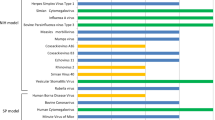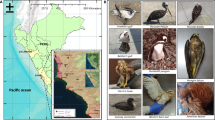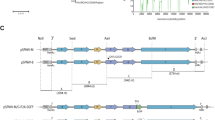Abstract
Influenza A viruses (IAVs) cause epidemics and pandemics that result in considerable financial burden and loss of human life. To manage annual IAV epidemics and prepare for future pandemics, an improved understanding of how IAVs emerge, transmit, cause disease and acquire pandemic potential is urgently needed. Fundamental techniques essential for procuring such knowledge are IAV isolation and culture from experimental and surveillance samples. Here we present a detailed protocol for IAV sample collection and processing, amplification in chicken eggs or mammalian cells, and identification from samples containing unknown pathogens. This protocol is robust, and it allows for the generation of virus cultures that can be used for downstream analyses. Once experimental or surveillance samples are obtained, virus cultures can be generated and the presence of IAVs can be verified in 3–5 d via reverse-transcription (RT)-PCR or hemagglutination assay. Increased time frames may be required for less experienced laboratory personnel, or when large numbers of samples will be processed.
This is a preview of subscription content, access via your institution
Access options
Subscribe to this journal
Receive 12 print issues and online access
$259.00 per year
only $21.58 per issue
Buy this article
- Purchase on Springer Link
- Instant access to full article PDF
Prices may be subject to local taxes which are calculated during checkout





Similar content being viewed by others
References
World Health Organization. Influenza (Seasonal) Fact Sheet No. 211 http://www.who.int/mediacentre/factsheets/fs211/en/index.html (2013).
Taubenberger, J.K. & Morens, D.M. 1918 influenza: the mother of all pandemics. Emerg. Infect. Dis. 12, 15–22 (2006).
Tong, S. et al. A distinct lineage of influenza A virus from bats. Proc. Natl. Acad. Sci. USA 109, 4269–4274 (2012).
World Health Organization. Influenza at the Human-Animal Interface–Summary and Assessment as of 27 June 2014. http://www.who.int/influenza/human_animal_interface/Influenza_Summary_IRA_HA_interface_27June14.pdf?ua=1 (2014).
Imai, M. et al. Experimental adaptation of an influenza H5 HA confers respiratory droplet transmission to a reassortant H5 HA/H1N1 virus in ferrets. Nature 486, 420–428 (2012).
Herfst, S. et al. Airborne transmission of influenza A/H5N1 virus between ferrets. Science 336, 1534–1541 (2012).
Chen, L.M. et al. In vitro evolution of H5N1 avian influenza virus toward human-type receptor specificity. Virology 422, 105–113 (2012).
Gao, R. et al. Human infection with a novel avian-origin influenza A (H7N9) virus. N. Engl. J. Med. 368, 1888–1897 (2013).
World Health Organization. WHO Risk Assessment, Human Infections with Avian Influenza A(H7N9) Virus, Summary of Surveillance and Investigation Findings as of 27 June 2014. http://www.who.int/influenza/human_animal_interface/influenza_h7n9/riskassessment_h7n9_27june14.pdf?ua=1 (2014).
Qi, X. et al. Probable person-to-person transmission of novel avian influenza A (H7N9) virus in Eastern China, 2013: epidemiological investigation. BMJ 347, f4752–4759 (2013).
Watanabe, T. et al. Characterization of H7N9 influenza A viruses isolated from humans. Nature 501, 551–555 (2013).
Belser, J.A. et al. Pathogenesis and transmission of avian influenza A (H7N9) virus in ferrets and mice. Nature 501, 556–559 (2013).
Zhu, H. et al. Infectivity, transmission, and pathology of human-isolated H7N9 influenza virus in ferrets and pigs. Science 341, 183–186 (2013).
Zhang, Q. et al. H7N9 influenza viruses are transmissible in ferrets by respiratory droplet. Science 341, 410–414 (2013).
World Health Organization. Manual for the Laboratory Diagnosis and Virological Surveillance of Influenza. http://whqlibdoc.who.int/publications/2011/9789241548090_eng.pdf (2011).
World Health Organization. Manual on Animal Influenza Diagnosis and Surveillance. http://www.who.int/csr/resources/publications/influenza/en/whocdscsrncs20025rev.pdf (2002).
World Health Organization. WHO Information for Molecular Diagnosis of Influenza Virus in Humans. http://www.who.int/influenza/gisrs_laboratory/molecular_diagnosis_influenza_virus_humans_update_201211.pdf (2012).
World Health Organization. Global Influenza Surveillance and Response System (GISRS). http://www.who.int/influenza/gisrs_laboratory/en/ (2013).
US Centers for Disease Control. Seasonal Influenza Activity and Surveillance US http://www.cdc.gov/flu/weekly/fluactivitysurv.htm (2013).
ECDC. European Influenza Surveillance Network (EISN) 〈http://ecdc.europa.eu/en/activities/surveillance/EISN/Pages/index.aspx〉 (2013).
World Health Organization. WHO Collaborating Centres for Influenza and Essential Regulatory Laboratories. http://www.who.int/influenza/gisrs_laboratory/collaborating_centres/list/en/ (2013).
Fouchier, R.A. et al. Detection of influenza A viruses from different species by PCR amplification of conserved sequences in the matrix gene. J. Clin. Microbiol. 38, 4096–4101 (2000).
van Elden, L.J., Nijhuis, M., Schipper, P., Schuurman, R. & van Loon, A.M. Simultaneous detection of influenza viruses A and B using real-time quantitative PCR. J. Clin. Microbiol. 39, 196–200 (2001).
Goodpasture, E.W., Woodruff, A.M. & Buddingh, G.J. The cultivation of vaccine and other viruses in the chorioallantoic membrane of chick embryos. Science 74, 371–372 (1931).
Ito, T. et al. Differences in sialic acid-galactose linkages in the chicken egg amnion and allantois influence human influenza virus receptor specificity and variant selection. J. Virol. 71, 3357–3362 (1997).
Lu, B., Zhou, H., Chan, W., Kemble, G. & Jin, H. Single amino acid substitutions in the hemagglutinin of influenza A/Singapore/21/04 (H3N2) increase virus growth in embryonated chicken eggs. Vaccine 24, 6691–6693 (2006).
Lu, B., Zhou, H., Ye, D., Kemble, G. & Jin, H. Improvement of influenza A/Fujian/411/02 (H3N2) virus growth in embryonated chicken eggs by balancing the hemagglutinin and neuraminidase activities, using reverse genetics. J. Virol. 79, 6763–6771 (2005).
Stevens, J. et al. Receptor specificity of influenza A H3N2 viruses isolated in mammalian cells and embryonated chicken eggs. J. Virol. 84, 8287–8299 (2010).
Katz, J.M. & Webster, R.G. Efficacy of inactivated influenza A virus (H3N2) vaccines grown in mammalian cells or embryonated eggs. J. Infect. Dis. 160, 191–198 (1989).
Kodihalli, S., Justewicz, D.M., Gubareva, L.V. & Webster, R.G. Selection of a single amino acid substitution in the hemagglutinin molecule by chicken eggs can render influenza A virus (H3) candidate vaccine ineffective. J. Virol. 69, 4888–4897 (1995).
Gaush, C.R., Hard, W.L. & Smith, T.F. Characterization of an established line of canine kidney cells (MDCK). Proc. Soc. Exp. Biol. Med. 122, 931–935 (1966).
Gaush, C.R. & Smith, T.F. Replication and plaque assay of influenza virus in an established line of canine kidney cells. Appl. Microbiol. 16, 588–594 (1968).
Tobita, K., Sugiura, A., Enomote, C. & Furuyama, M. Plaque assay and primary isolation of influenza A viruses in an established line of canine kidney cells (MDCK) in the presence of trypsin. Med. Microbiol. Immunol. 162, 9–14 (1975).
Davies, H.W., Appleyard, G., Cunningham, P. & Pereira, M.S. The use of a continuous cell line for the isolation of influenza viruses. Bull. World Health Organ. 56, 991–993 (1978).
Meguro, H., Bryant, J.D., Torrence, A.E. & Wright, P.F. Canine kidney cell line for isolation of respiratory viruses. J. Clin. Microbiol. 9, 175–179 (1979).
Lazarowitz, S.G. & Choppin, P.W. Enhancement of the infectivity of influenza A and B viruses by proteolytic cleavage of the hemagglutinin polypeptide. Virology 68, 440–454 (1975).
Klenk, H.D., Rott, R., Orlich, M. & Blodorn, J. Activation of influenza A viruses by trypsin treatment. Virology 68, 426–439 (1975).
Skehel, J.J. & Wiley, D.C. Receptor binding and membrane fusion in virus entry: the influenza hemagglutinin. Annu. Rev. Biochem. 69, 531–569 (2000).
Hatakeyama, S. et al. Enhanced expression of an α2,6-linked sialic acid on MDCK cells improves isolation of human influenza viruses and evaluation of their sensitivity to a neuraminidase inhibitor. J. Clin. Microbiol. 43, 4139–4146 (2005).
Hirst, G.K. The agglutination of red cells by allantoic fluid of chick embryos infected with influenza virus. Science 94, 22–23 (1941).
Francis, T., Pearson, H.E., Salk, J.E. & Brown, P.N. Immunity in human subjects artificially infected with influenza virus, type B. Am. J. Public Health Nations Health 34, 317–334 (1944).
Ito, T. et al. Receptor specificity of influenza A viruses correlates with the agglutination of erythrocytes from different animal species. Virology 227, 493–499 (1997).
Medeiros, R., Escriou, N., Naffakh, N., Manuguerra, J.C. & van der Werf, S. Hemagglutinin residues of recent human A(H3N2) influenza viruses that contribute to the inability to agglutinate chicken erythrocytes. Virology 289, 74–85 (2001).
Wiriyarat, W. et al. Erythrocyte binding preference of 16 subtypes of low-pathogenic avian influenza and 2009 pandemic influenza A (H1N1) viruses. Vet. Microbiol. 146, 346–349 (2010).
Gavin, P.J. & Thomson, R.B. Jr. Review of rapid diagnostic tests for influenza. Clin. Appl. Immunol. Rev. 4, 151–172 (2003).
Hurt, A.C., Alexander, R., Hibbert, J., Deed, N. & Barr, I.G. Performance of six influenza rapid tests in detecting human influenza in clinical specimens. J. Clin. Virol. 39, 132–135 (2007).
Nutter, S. et al. Evaluation of indirect fluorescent antibody assays compared to rapid influenza diagnostic tests for the detection of pandemic influenza A (H1N1) pdm09. PLoS ONE 7, e33097 (2012).
Al Johani, S.M., Al Balawi, M., Al Alwan, B., Al Hefdhi, R. & Hajeer, A. Validity of two rapid point-of-care influenza tests and direct fluorescence assay in comparison of real-time PCR for swine of origin influenza virus. J. Infect. Public Health 4, 7–11 (2011).
Rahman, M. et al. Performance of Directigen flu A+B enzyme immunoassay and direct fluorescent assay for detection of influenza infection during the 2004–2005 season. Diagn. Microbiol. Infect. Dis. 58, 413–418 (2007).
Hirst, G.K. The quantitative determination of influenza virus and antibodies by means of red cell agglutination. J. Exp. Med. 75, 49–64 (1942).
Rowe, T. et al. Detection of antibody to avian influenza A (H5N1) virus in human serum by using a combination of serologic assays. J. Clin. Microbiol. 37, 937–943 (1999).
World Health Organization. Serological Diagnosis of Influenza by Microneutralization Assay. http://www.who.int/influenza/gisrs_laboratory/2010_12_06_serological_diagnosis_of_influenza_by_microneutralization_assay.pdf (2006).
St. George, K. Diagnosis of influenza virus. In Influenza Virus: Methods and Protocols Methods in Molecular Biology (eds. Kawaoka, Y. & Neumann, G.) Ch. 4, (Humana Press, 2012).
Hoffmann, E., Stech, J., Guan, Y., Webster, R.G. & Perez, D.R. Universal primer set for the full-length amplification of all influenza A viruses. Arch. Virol. 146, 2275–2289 (2001).
Lee, C.W., Senne, D.A. & Suarez, D.L. Development and application of reference antisera against 15 hemagglutinin subtypes of influenza virus by DNA vaccination of chickens. Clin. Vaccine Immunol. 13, 395–402 (2006).
US Centers for Disease Control. Biosafety in Microbiological and Biomedical Laboratories (BMBL) 5th edn, http://www.cdc.gov/biosafety/publications/bmbl5/ (2009).
Kostka, V. & Carpenter, F.H. Inhibition of chymotrypsin activity in crystalline trypsin preparations. J. Biol. Chem. 239, 1799–1803 (1964).
World Health Organization. WHO Collaborating Centres. http://www.who.int/collaboratingcentres/en/ (2013).
Daley, P., Castriciano, S., Chernesky, M. & Smieja, M. Comparison of flocked and rayon swabs for collection of respiratory epithelial cells from uninfected volunteers and symptomatic patients. J. Clin. Microbiol. 44, 2265–2267 (2006).
Walsh, P. et al. Comparison of respiratory virus detection rates for infants and toddlers by use of flocked swabs, saline aspirates, and saline aspirates mixed in universal transport medium for room temperature storage and shipping. J. Clin. Microbiol. 46, 2374–2376 (2008).
Munywoki, P.K. et al. Improved detection of respiratory viruses in pediatric outpatients with acute respiratory illness by real-time PCR using nasopharyngeal flocked swabs. J. Clin. Microbiol 49, 3365–3367 (2011).
Hernes, S.S. et al. Swabbing for respiratory viral infections in older patients: a comparison of rayon and nylon flocked swabs. Eur. J. Clin. Microbiol. Infect. Dis. 30, 159–165 (2011).
Wadowsky, R.M., Laus, S., Libert, T., States, S.J. & Ehrlich, G.D. Inhibition of PCR-based assay for Bordetella pertussis by using calcium alginate fiber and aluminum shaft components of a nasopharyngeal swab. J. Clin. Microbiol. 32, 1054–1057 (1994).
Wiebe, J.P. & Dinsdale, C.J. Inhibition of cell proliferation by glycerol. Life Sci. 48, 1511–1517 (1991).
Miller, G.L. Influence of pH and of certain other conditions on the stability of the infectivity and red cell agglutinating activity of influenza virus. J. Exp. Med. 80, 507–520 (1944).
Wang, X., Zoueva, O., Zhao, J., Ye, Z. & Hewlett, I. Stability and infectivity of novel pandemic influenza A (H1N1) virus in blood-derived matrices under different storage conditions. BMC Infect. Dis. 11, 354 (2011).
Beato, M.S. et al. Infectivity of H7 LP and HP influenza viruses at different temperatures and pH and persistence of H7 HP virus in poultry meat at refrigeration temperature. Virology 433, 522–527 (2012).
Greiff, D., Blumenthal, H., Chiga, M. & Pinkerton, H. The effects on biological materials of freezing and drying by vacuum sublimation. II. Effect on influenza virus. J. Exp. Med. 100, 89–101 (1954).
World Health Organization. Collecting, Preserving and Shipping Specimens for the Diagnosis of Avian Influenza A(H5N1) Virus Infection. http://www.who.int/csr/resources/publications/surveillance/CDS_EPR_ARO_2006_1.pdf (2006).
Acknowledgements
The authors are grateful to M. Hatta, S. Fan, J. Ping, Z. Najacht and A. Karasin for helpful discussions, to P. Jester and Z. Najacht for assistance with hemagglutination assay and RT-PCR figure components and to S. Watson for scientific editing of the manuscript. This work was supported by grants-in-aid from the Ministry of Health, Labour and Welfare, Japan, by ERATO (Japan Science and Technology Agency), by US National Institute of Allergy and Infectious Diseases (NIAID) Public Health Service research grants and by a NIAID-funded Center for Research on Influenza Pathogenesis grant (CRIP, HHSN266200700010C).
Author information
Authors and Affiliations
Contributions
A.J.E., G.N. and Y.K. wrote the manuscript.
Corresponding author
Ethics declarations
Competing interests
The authors declare no competing financial interests.
Rights and permissions
About this article
Cite this article
Eisfeld, A., Neumann, G. & Kawaoka, Y. Influenza A virus isolation, culture and identification. Nat Protoc 9, 2663–2681 (2014). https://doi.org/10.1038/nprot.2014.180
Published:
Issue Date:
DOI: https://doi.org/10.1038/nprot.2014.180
This article is cited by
-
Single-virus tracking with quantum dots in live cells
Nature Protocols (2023)
-
Proteomic and genetic analyses of influenza A viruses identify pan-viral host targets
Nature Communications (2023)
-
Orthogonally-tunable and ER-targeting fluorophores detect avian influenza virus early infection
Nature Communications (2022)
-
Bioactive lipid screening during respiratory tract infections with bacterial and viral pathogens in mice
Metabolomics (2022)
-
Deimmunization of flagellin for repeated administration as a vaccine adjuvant
npj Vaccines (2021)
Comments
By submitting a comment you agree to abide by our Terms and Community Guidelines. If you find something abusive or that does not comply with our terms or guidelines please flag it as inappropriate.



